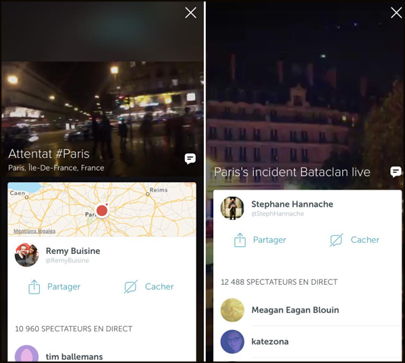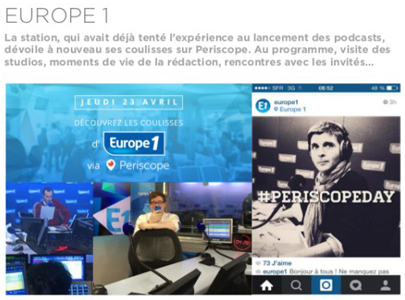
Nicolas Becquet is a journalist, trainer and head of digital platforms at L'Echo in Belgium. This piece was originally published by meta-media.fr and is republished here with permission. Translated by Paul McNally.
Media coverage following the Paris attacks has highlighted what we've already known for a long time: smartphones are great at capturing an event in real-time and from all angles. The coverage also confirmed that journalists are lagging behind or are even absent altogether from this revolution, this move towards such a portable method of production, despite its potential.
While in the newsroom there is now a consensus on the need to cater for mobile users – who are growing in numbers and in some cases make up the majority of a news site's audience – it's quite a different picture when it comes to actually producing content on a smartphone or tablet.
Four years ago, trying to shoot and edit a video with your phone was a risky experiment. Today, technological developments have completely changed that, with greatly increased processor power, a 4G network, full HD or even 4K video, longer battery life, sophisticated apps approaching professional standards, and file formats customised for mobile distribution.
Filming, editing and publishing live video has become child's play, needing minimal preparation. However, in the French-speaking media at least, examples of this in practice are still few and far between.
There are some exceptions such as Le Télégramme in Brittany and the Ouest France local media group, which gave iPhones to reporters in 2011. This summer, Swiss broadcaster Léman Bleu shot all of its TV news reports on an iPhone 6, which was hailed as a successful experiment.
Since the beginning of 2015, French radio station Europe 1 has also been creating videos on a smartphone. Local publishers are showing an interest in lightweight tools to cover sporting events and news. Some local public TV channels in Europe are now training their journalists in this approach, through Circom, the European association of regional television broadcasters.The potential for immersive livestreams coupled with the expertise of a journalist offers some impressive opportunities, and all at a low costNicolas Becquet
The IPJ journalism school in Paris and the journalism and digital media masters programme in the eastern French city of Metz have also started providing mobile journalism workshops – a movement followed by some press clubs in France and Belgium that train freelances keen to enrich the content they can offer while expanding their potential sources of income. French news site Rue89, meanwhile, produced a very useful online course called "Writing and producing a video: new formats for web and mobile" (in French).
Developing video is high up on media groups' strategic priorities, but, as with any new training process, if the day-to-day operation of the newsroom does not adapt to the new practices being taught, then good habits do not form and only a handful of curious journalists will keep up the experiment.
If you're still not sure about the potential of mobile journalism, an experiment put together by Swiss public broadcaster RTS provides a telling case study. Swiss journalist Nicolae Schiau followed five refugees from the Syrian border to Europe. Equipped with a phone and a GoPro, he recounted his journey in real time – an inventive and immersive use that perfectly illustrates the philosophy of mobile journalism.
International French TV network France 24 has also worked with mobile journalism, particularly with Periscope. France 24's attempts are interesting because they don't try to reproduce traditional TV storytelling, but taking advantage of mobile opportunities.
Julien Pain did so during Vladimir Putin's press conference in Moscow in December. Through Periscope and Twitter, he asked people in the conference room what they expected from Vladimir Putin, bringing viewers closer to the event through the live footage. He also met an opposer in a taxi, children in a classroom, and “pro-Putin hipsters”. This live road trip through Moscow was unusual, exciting and newsworthy.
Sylvain Mornet, France 24 chief video editor, also experimented with mobile journalism during ComicCon in Paris, as well as when the Musée de l'Homme reopened after several years of works. The Periscope sessions are unfortunately no longer available, but you can still watch Twitter videos and read the case study in Social Newsroom Review (UER).

In the UK and Ireland, it seems mobile journalism is being taken much more seriously. Over the past two years, about 1,000 journalists at the BBC and Irish public broadcaster RTE have been given mobile training, and 3,000 smartphones have been handed out to staff. The objective is to create reports with a style better adapted to mobile use, in both the creative process and the distribution. The BBC has also created an application dedicated to collecting sound, image and video: Mobile News Gathering.
Championed by RTE and a handful of journalists including Glen Mulcahy, Robb Montgomery, Neal Augenstein, Marc Settle and Philip Bromwell, mobile journalism now even has its own festival: MoJoCon. This year, the event brought together journalists, video professionals and start-ups developing dedicated apps and accessories.
In the US, the number of news videos filmed on a smartphone has grown rapidly since 2011, when The Wall Street Journal partnered with the mobile platform Tout. Using a dedicated app, any journalist can send a 20-second video snapshot to appear alongside an article or on a dedicated page.
Periscope and the Paris attacks
Back to what happened on the weekend of 13 November in Paris. Residents from all over the city began livestreaming on Periscope and a large number of amateur videos were broadcast on television channels the world over, sometimes sold for high prices.
With a few exceptions, such as a video shot by the German journalist Philipp Weber, the livestreamed videos were the work of ordinary members of the public. The images are shaky, they are shot vertically and accompanied by spontaneous comments based on emotion, issues that were quickly excused by the opportunity they offered, that of instant access to an extraordinary situation in real-time.
This dramatic immediacy at the very heart of a developing news story overrides all other considerations and attracts substantial viewers. Some Periscope users in the city reached more than 2,000 viewers around the world in a single broadcast. Rémy Buisine, Moctar Kane and Stéphane Hannache were among the most followed accounts on the night of the attacks.

Here in Brussels, I found myself following, by chance, the live reports of a former top model turned lifestyle blogger who shot the scenes from her balcony on Periscope. For three days, Chantal Hoogvliet used her smartphone to capture the vigils, the minute of silence and the post-attacks atmosphere. With 81,531 subscribers, 700 users on average per broadcast and 1,400 replays, this Periscope user managed to bring together an impressive community.
But where are the journalists?
When such tragic and sudden events happen, newsrooms already have a lot to do, but it seems urgent now that media groups think more about using lightweight and portable tools which can:
- put reporters at the heart of the action
- lead to new narrative formats
- reach a connected, mobile and potentially international audience
- use social media to its full potential
- make journalists on the ground more flexible and agile
Pierre Monégier, who works for Envoyé Special on France 2 TV, used Periscope to broadcast the minute's silence at Paris City Hall, as well as some of the speeches made, while letting the images run without adding any comments.
The paradox is that Periscope is being used a lot by some news groups, but from the comfort of their nice warm offices, in a studio environment, with the mobility and spontaneity of a marketing exercise. They are taking a potentially disruptive application and applying traditional thinking, with classic production methods: a studio, interviews, fixed broadcast times.

It's not just about video
Mobile journalism is obviously not just limited to live video. The multimedia approach offers the ability to easily mix text, images and sound on the ground. There are a host of tools designed to produce, distribute and consume information on the move, such as Storehouse.
Masters students in journalism and digital media at Metz University spent a day testing out the possibilities offered by mobile journalism: enriching articles, producing reports on the ground – the formats and variations are endless. But if, as with the emergence of the web in newsrooms, we simply talk about the importance of turning digital without providing the means to do so, there is little chance that mobile journalism will ever deliver its full potential.
A smartphone will never replace a professional camera nor the expertise of a seasoned video journalist, but it will be of great use to any journalist confronted with the immediate need to bear witness to what is happening before their eyes.
The tools are available
Tempted by mobile journalism? Here is a basic toolkit with apps and the accessories required. It's lightweight, inexpensive and provides results that conform to web standards.


Read more about apps, tools and techniques for mobile journalism here, and check out our guide to help you get started in mobile journalism.
Update: This article has been updated to clarify that MoJoCon is organised by RTE, the Irish public service broadcaster.
Free daily newsletter
If you like our news and feature articles, you can sign up to receive our free daily (Mon-Fri) email newsletter (mobile friendly).
Related articles
- New project InOldNews wants to improve representation in video journalism
- 38 mojo apps from BBC trainer Marc Blank-Settle
- 15 online communities for journalists you should know about
- Ukrainian journalists use smartphones to tell stories of displaced communities
- 10 video editing apps for mobile journalists









